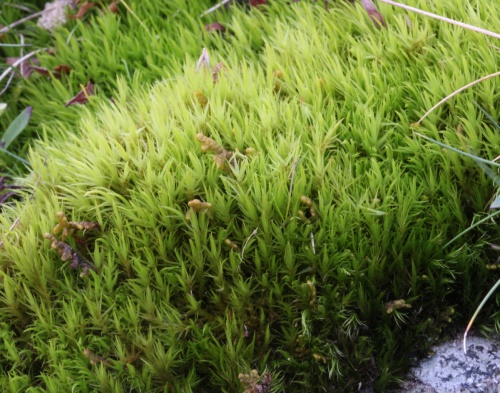Broom Fork-moss - Dicranum scoparium
This moss can reach up to 10 cm in height and forms yellow green or dark green cushions or large patches. The leaves are 4 to 7.5 mm long, narrowly spearhead-shaped and taper to a long fine tip composed largely of the strong nerve. They are often somewhat curved, but can also be straight and are hardly altered when dry. The leaf margins are usually strongly toothed near the tip. The back of the nerve has raised lines of cells which are just visible with a hand lens. These are also toothed, making the tip of the leaf appear toothed all round. D. scoparium occasionally produces deciduous shoots with smaller leaves at the tip of the stems. The curved, cylindrical capsule is common in the north and west of Britain, and is borne on a long seta that is yellow above and reddish below.
On the ground in woodland, but also on trees and logs, acid rocks etc.
All year round.
Widespread and frequent in Britain.
Fairly frequent in Leicestershire and Rutland.
Leicestershire & Rutland Map
Enter a town or village to see local records
MAP KEY:
Yellow squares = NBN records (all known data)
Coloured circles = NatureSpot records: 2020+ | 2015-2019 | pre-2015
UK Map
Species profile
- Common names
- Broom Fork-moss
- Species group:
- Mosses & Liverworts
- Kingdom:
- Plantae
- Order:
- Dicranales
- Family:
- Dicranaceae
- Records on NatureSpot:
- 44
- First record:
- 07/04/1993 (Dennis Ballard)
- Last record:
- 26/02/2024 (Hamzaoui, Uta)
Total records by month
% of records within its species group
10km squares with records
The latest images and records displayed below include those awaiting verification checks so we cannot guarantee that every identification is correct. Once accepted, the record displays a green tick.
In the Latest Records section, click on the header to sort A-Z, and again to sort Z-A. Use the header boxes to filter the list.








